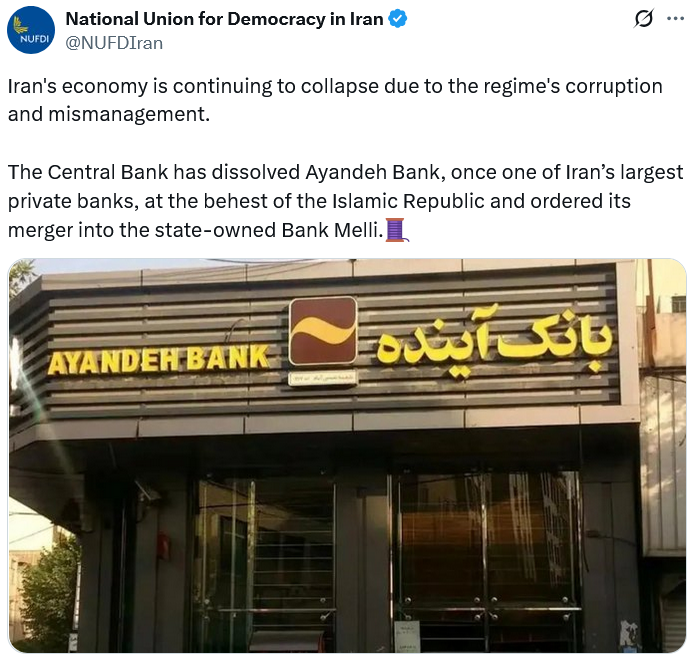
One of Iran’s prominent private banking institutions, Ayandeh Bank, has entered bankruptcy, prompting the state-owned Bank Melli to absorb the assets of more than 42 million customers.
Ayandeh Bank’s bankruptcy was announced on Thursday, following a staggering accumulation of approximately $5.1 billion in losses and close to $3 billion in debt, as reported by local media outlets, including Iran International.
This declaration came shortly after the Central Bank of Iran was unable to save the struggling bank, which had operated 270 branches throughout the nation, ultimately leading to its closure.
The situation has affected over 42 million customers, as outlined by Iran News Update.
 Source: National Union for Democracy in Iran
Source: National Union for Democracy in Iran
While CBI Governor Mohammad Reza Farzin reassured Ayandeh’s clients that they would be able to regain their savings right away, this incident underscores the perils of relying on banks that leverage customer deposits, function with fractional reserves, and seek bailouts during crises.
Failures in the banking sector were allegedly among the motivations that drove Satoshi Nakamoto to establish Bitcoin, as indicated by a message embedded in Bitcoin’s genesis block referencing the UK’s government bailout of banks.
One of the factors boosting Bitcoin’s growth in recent years was the US banking turmoil at the beginning of 2023, during which entities like Silicon Valley Bank and Signature Bank either declared bankruptcy or faced liquidation.
Bitcoin’s value surged from below $20,000 to over $29,000 in that month due to diminishing public confidence in the US banking framework.
Earlier this month, a report from Morningstar noted that US regional banks still showed indications of financial distress despite augmentation of reserves and customer deposits since March 2023.
Eight Iranian banks face potential closure
Iran’s banking framework has become precarious due to extensive sanctions that inhibit access to global financial networks while undermining US dollar transactions and augmenting risks within local banks as the Iranian rial continually loses value.
Additionally, the Central Bank recently cautioned that eight other domestic banks risk failure unless reforms are executed. Iranian cryptocurrency exchanges are also facing challenges, with Nobitex experiencing a $81 million hack earlier this year.
This event significantly contributed to a 11% decline in Iranian crypto flows up until July amid ongoing conflicts with Israel.


